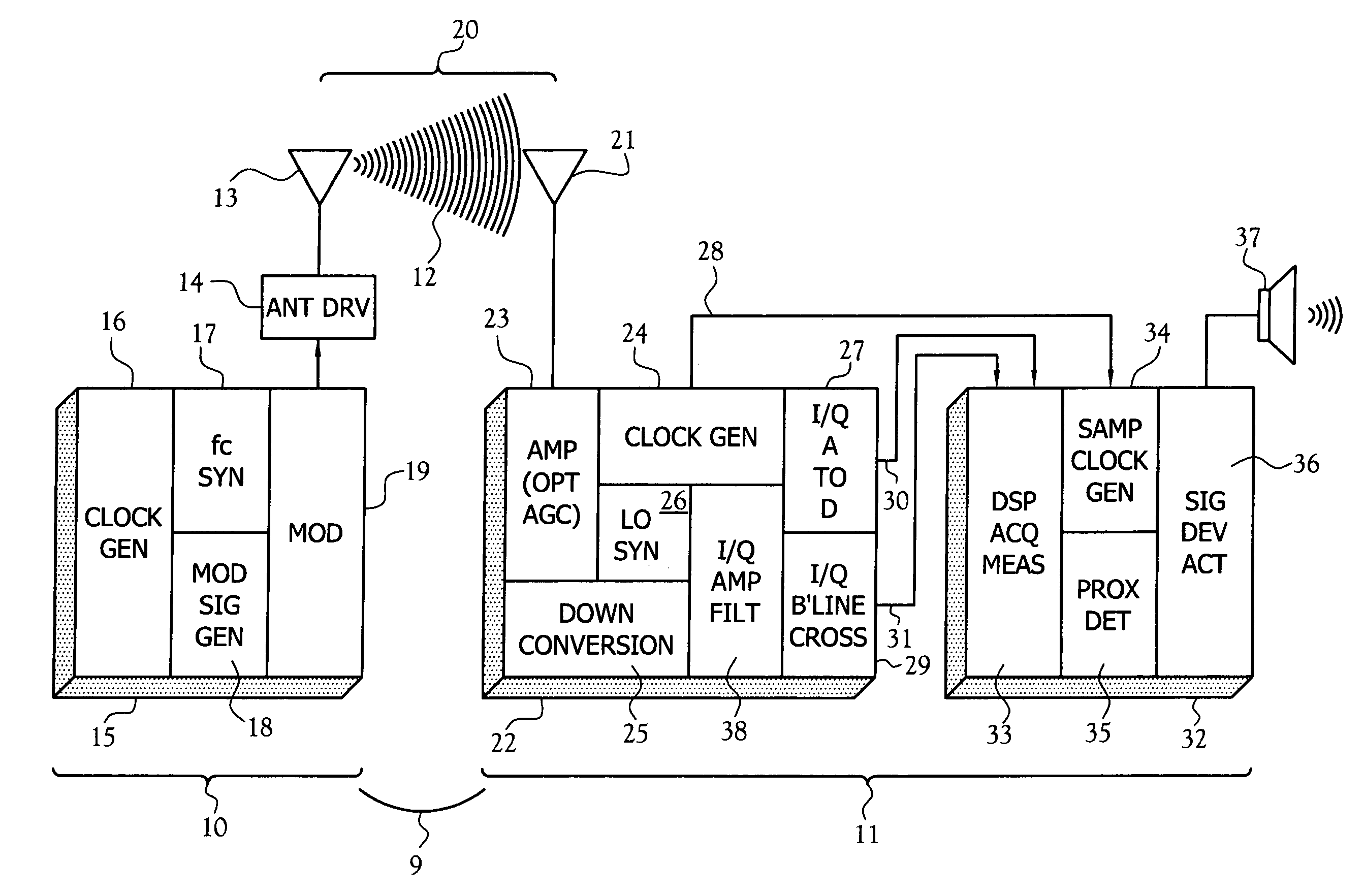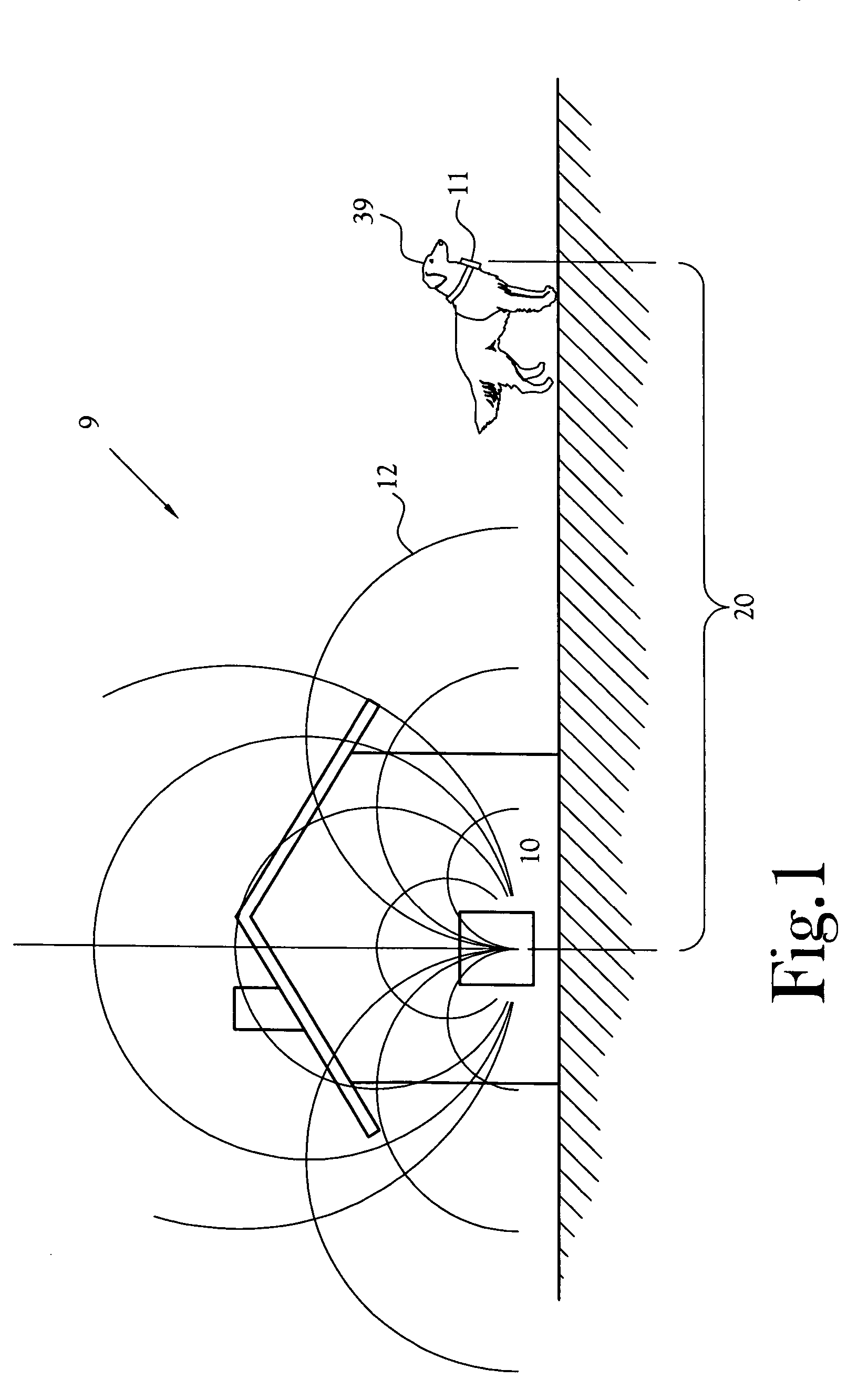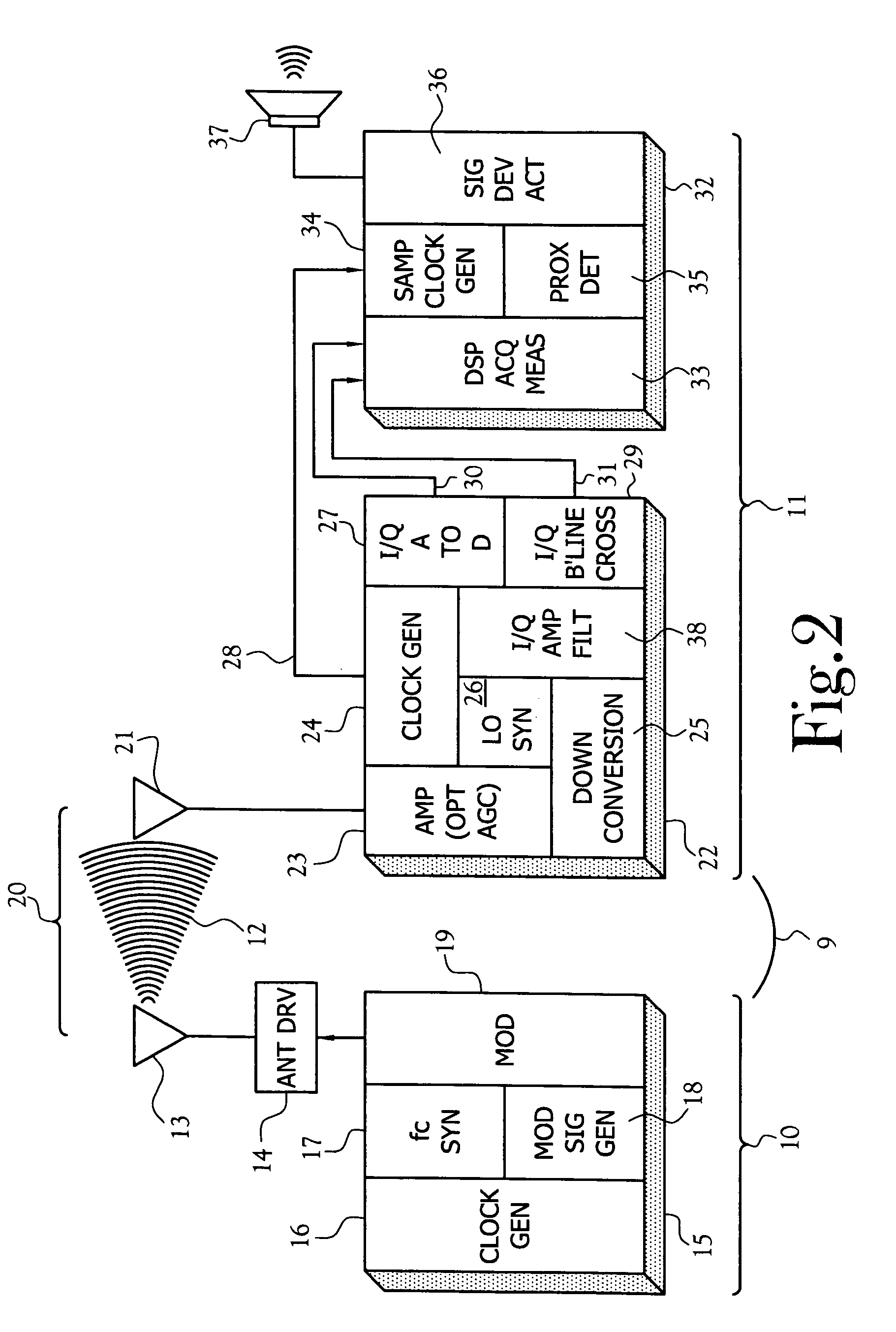[0012]The above discussed prior art problems and limitations are effectively remedied in the present invention of an improved system for determining when a receiver is proximate to a wireless boundary encompassing and defined with reference to the location of a transmitter. The present invention is based on near-field signal detection of the total power in a low-frequency (10 kHz to 100 kHz), quasi-static 3-axis magnetic field. Quasi-static magnetic fields are generally known to be immune to the field-strength variability problems that can occur in systems based on propagating RF fields because of multipath reflections and severe field distortion by proximate conducting masses such as body tissue. Operation in the near-field or quasi-static magnetic field zone is also generally known to be advantageous for wireless boundary proximity detection because the sharp inverse 6th power proportionality of the magnetic field power with distance allows for more accurate range thresholding decisions. The receiver module used to detect the magnetic field in the present invention is not required to transmit any signals and therefore can have lower cost and power, much longer battery life and simpler and more compact construction compared to prior art methods that require the portable device to transmit either an RF or ultrasonic signal. The receiver module in the present invention uses a novel single-output, two axis sensing antenna with orientation-independent response for detecting the total power in a 3-axis magnetic field signal. This provides for more accurate wireless boundary proximity detection performance compared to prior art methods using only a single-axis sensing antenna. The present invention receiver module achieves accurate, orientation-independent boundary detection using only one, non-multiplexed signal receiver circuit. This also allows for lower cost and power, longer battery life and simpler and more compact construction compared to prior art methods that can only achieve orientation-independent boundary detection through the use of a multiplicity of single-axis sensing antennas and a corresponding multiplicity of receiver circuits.
[0013]The present invention uses a composite magnetic field which is continuously broadcast and detected with no time-sequential multiplexing required for either the magnetic field signal generation, reception or detection. This allows for use of a magnetic field detection process incorporating coherent filtering to advantageously reject interference signals associated with the power line frequency of either 50 or 60 Hz. This allows the present invention to be much less susceptible to common sources of power line interference compared to prior art methods not incorporating rejection filtering of the power line frequency. In fact, coherent rejection filtering at the power line frequency is not possible for the prior art methods that require receiver antenna sequencing or multiplexing. The present invention uses continuous, coherent binary phase shift keying (BPSK) modulation signals to modulate a 3-axis magnetic field which is detected by a direct quadrature conversion receiver that translates the received signal directly into continuous, coherent quadrature I and Q baseband components. This method of carrier modulation and down conversion allows for a lower effective noise bandwidth in the post conversion filter compared to the noise bandwidths of several kilohertz exhibited by prior art methods based on magnetic fields modulated in a time sequential fashion using on-off amplitude keying or modulated using differential phase shift keying (DPSK) at rates in excess of 1 kHz. Additionally the use of BPSK modulation is generally known to have theoretically superior intrinsic signal to noise and bit error rate performance compared to DPSK. A lower receiver noise bandwidth is advantageous for achieving better signal-to-noise ratio for the magnetic field measurement resulting in more accurate and higher resolution boundary detection. The present invention uses digital signal processing of the sampled baseband signals to further improve the boundary detection accuracy compared to prior art methods that do not employ digital signal processing. Because the sigma delta modulators used for 9-bit (8 bits plus sign bit) signal digitization employ continuous time integration, the digital correlation filters used to process the baseband data samples have a theoretical performance equivalent to ideal matched filters for extracting the signals from random noise and for extracting the separately identifiable 3-axis magnetic field components from the composite received signal. Digital post processing is also used to advantage in the present invention for digitally combining the extracted measures of the 3-axis magnetic field components to form an orientation-independent digital measure of the total magnetic field power, and for additionally filtering the power measure with a digital moving average filter to achieve an overall receiver system noise bandwidth on the order of 2 Hz.
[0014]Compared to prior art methods, the present invention additionally provides means to detect when the magnetic field rapidly decreases due to a transmitter sudden failure or loss-of-power. In the case of a pet containment application, this prevents the pet from being shocked if the magnetic field transmitter is accidentally turned off or otherwise loses power. Compared to prior art methods, the present invention additionally provides means to detect when the received baseband signals are exceptionally noisy. In the case of a pet containment application, this feature is useful for preventing a high magnetic field noise level, such as that encountered near an automobile engine, from being erroneously interpreted as a valid magnetic field power signal. Without this feature a pet may run into the street near the front of an automobile and not receive a correction because the detection device has no facility for distinguishing between a high level of magnetic field noise and a bona fide containment zone magnetic field signal. The present invention transmitter integrates all the signal generation circuitry onto a CMOS integrated circuit chip and can therefore be lower cost and more compact compared to prior art methods that do not utilize a single chip for all signal generation circuits. Similarly, the present invention receiver module integrates the entire signal receiving circuitry onto a CMOS integrated circuit receiver chip and can therefore be lower cost and more compact compared to prior art methods that do not use a single integrated circuit receiver chip. The receiver module also integrates all the digital signal processing circuitry onto a digital CMOS integrated circuit chip and therefore typically has lower cost and more compact compared to prior art methods that do not integrate all digital functions onto a single chip or that implement the digital processing with a general purpose microprocessor chip.
[0016]The transmitter employs means for continuously broadcasting a 3-axis composite magnetic field having a single carrier frequency modulated using coherent binary phase shift keying (BPSK). The CMOS signal generation chip is provided with a master clock oscillator. Making the carrier frequency an integral multiple of the line power frequency is advantageous for enabling the signal detection process to have a high degree of rejection of interference from the power line frequency or any of its significant harmonics. A system clock frequency of 32,760 Hz also allows the use of simple integral ratio frequency division for the generation of modulation waveforms having fundamental frequencies which are integral sub-harmonics of the power line frequency. The 3-axis modulation signals are specifically chosen to facilitate a receiver module digital signal detection process which has a high degree of rejection of interference at the power line frequency or any of its significant harmonics and which allows accurate decomposition of the composite received signal into separately identifiable components corresponding to the separately identifiable signals broadcast from each transmitter antenna. To this end, a first modulation signal is a squarewave of fundamental frequency equal to ¼ the power line frequency and the second and third modulation signals are orthogonal squarewaves of fundamental frequency equal to ½ the power line frequency. Thus, each modulation signal exhibits zero cross-correlation with the power line frequency or any of its harmonics when cross-correlated over a full period of the first modulation signal. This property is advantageous for implementing device digital correlation filters that are highly effective for rejecting common sources of electromagnetic power line interference signals. Also, a correlation waveform having fundamental squarewave frequency of ¼ the power line frequency (like the transmitter first modulation signal) exhibits zero cross-correlation with the transmitter second and third modulation signals when correlated over a full cycle, irrespective of any particular phase relationship between the correlation waveform and the signals. This property is advantageous for implementing simple and robust digital means for phase locking the receiver module data acquisition clock with the transmitter modulation signals. The magnetic field is broadcast from the transmitter with a 3-axis orthogonal antenna arrangement implemented with a total of four coils, each of identical construction for cost-efficient manufacture. The coils are mounted in a 3-dimensional configuration which may be enclosable by the smallest possible housing in a symmetric arrangement that effectively excludes any magnetic field cross-coupling between the orthogonal antenna elements.
[0018]The receiver module is provided with a low-cost digital CMOS integrated circuit chip for processing the I and Q sigma delta bit streams and baseline crossing countable pulse streams produced by the CMOS receiver chip. The digital circuit includes logic, memory, digital filter and digital arithmetic circuits for downsampling the downsampling the sigma delta I and Q bit streams to produce signed 8-bit I and Q data sampled at a rate nominally equivalent to 2× the power line frequency. The sampling rate clock is obtained by integer division of the 32,760 Hz system clock where the division ratio is “dithered” to establish and maintain receiver module phase locking with the phase of the transmitter modulation signals. The digital chip also provides digital correlation of 8 successive I and Q sampled data sets to extract sets of sample measures of the separately identifiable portions of the I and Q received baseband signals resulting from the separately identifiable magnetic field intensity components broadcast by the transmitter first, second and third antennas. The 8-set correlations are clocked by a measurement rate clock which is the sampling clock divided by eight and therefore nominally ¼ the power line frequency. The correlations are done with a simple and compact digital addition or subtracting means whereby each I or Q data sample needs to be accumulated only once per measurement cycle. Although the correlations are done with simple digital means, the results match very closely with ideal continuous time correlation since the sigma delta modulators employ continuous time integrators and the reference waveforms for matched filter correlation are all symmetric, unit amplitude square waves such that correlation by adding or subtracting is exactly equivalent to continuous time correlation. In addition to providing nearly ideal matched filter extraction of the separately identifiable magnetic field component measures, the correlation filters also provide near ideal rejection of power line interference components because the reference correlation waveforms are coherent and integral sub-harmonics of the power line frequency. Additionally, the correlation filtering process provides complete rejection of any dc components in the I and Q signal samples.
[0020]The digital chip also includes an 8-tap moving average digital filter for improving the signal to noise ratio associated with the total magnetic field power measure. The power measures are initially computed at a measurement rate of nominally ¼ the power line frequency or 15 samples per second for the case of 60 Hz power. Thus the averaged power measure from the moving average filter is totally refreshed every 0.533 seconds, and the effective noise bandwidth of the averaged data measurement is on the order of only 2 Hz.
 Login to View More
Login to View More  Login to View More
Login to View More 


